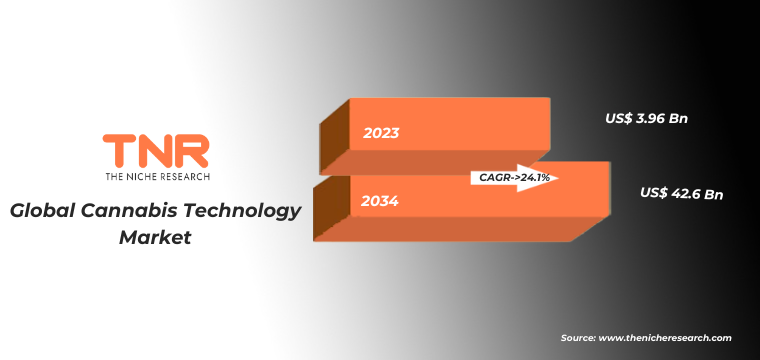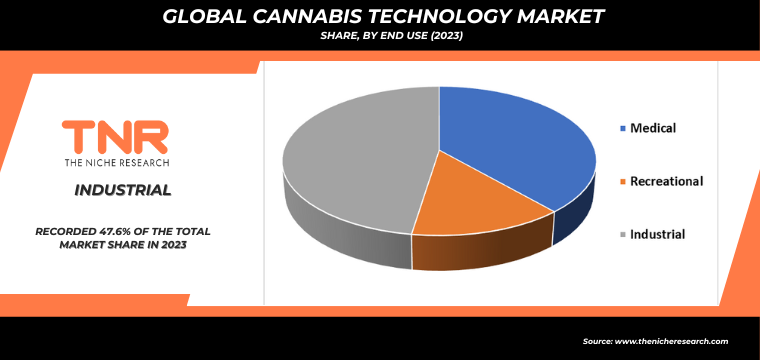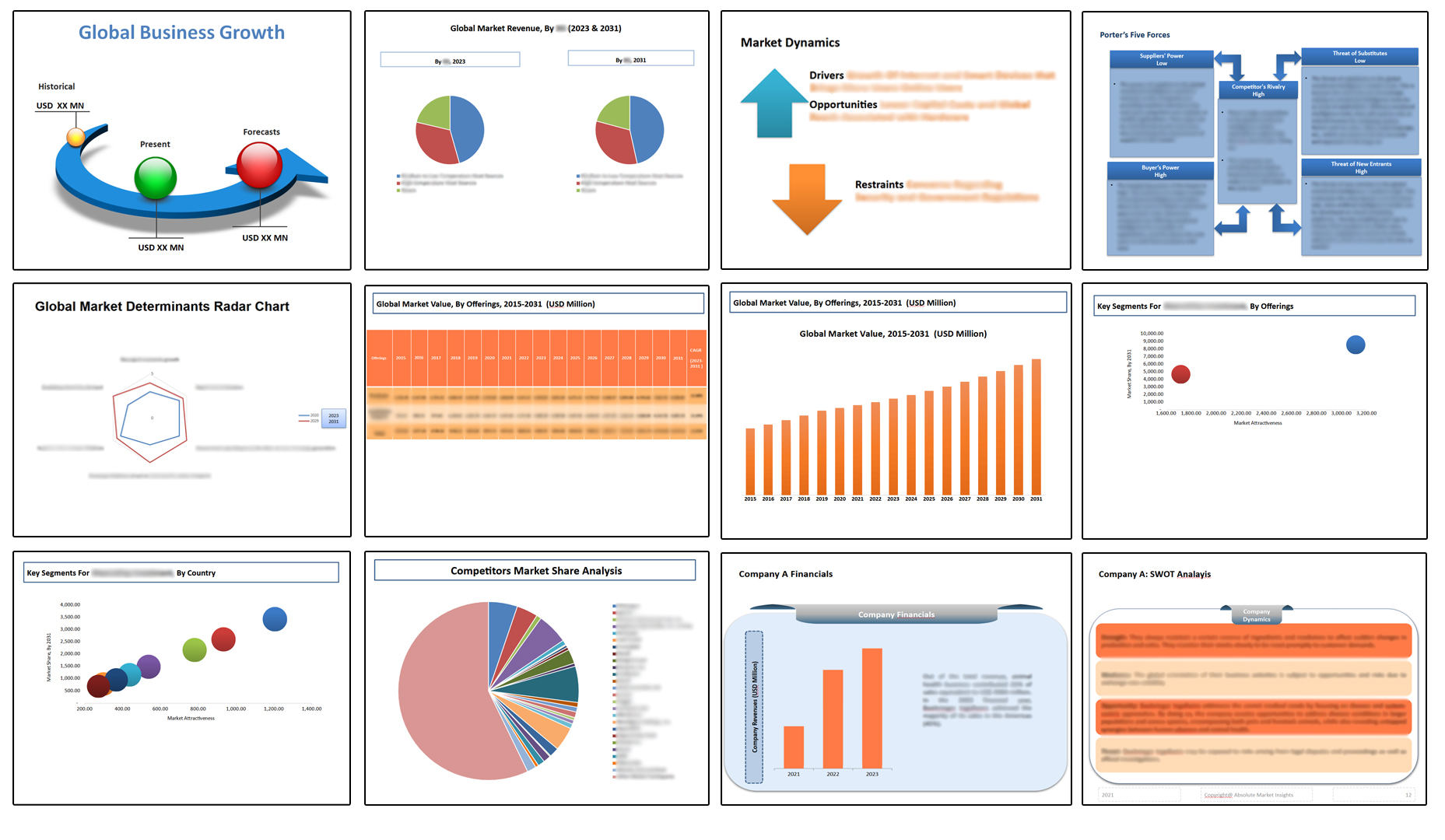Global Cannabis Technology Market: By Component, By Distribution Channel, By Application, By End Use, By Region & Segmental Insights Trends and Forecast, 2024 – 2034
- Industry: Healthcare
- Report ID: TNR-110-1116
- Number of Pages: 420
- Table/Charts : Yes
- June, 2024
- Base Year : 2024
- No. of Companies : 10+
- No. of Countries : 29
- Views : 10183
- Covid Impact Covered: Yes
- War Impact Covered: Yes
- Formats : PDF, Excel, PPT
Cannabis technology refers to the wide array of technological innovations and solutions developed to support the cultivation, processing, distribution, and consumption of cannabis. These technologies encompass various domains, including agricultural hardware, extraction and processing equipment, laboratory testing tools, software for compliance and inventory management, and consumer-facing applications such as e-commerce platforms and delivery services. The primary goal of cannabis technology is to enhance efficiency, ensure product quality, maintain regulatory compliance, and improve the overall consumer experience in the cannabis industry.
Consumer preferences are evolving, with increasing demand for a variety of cannabis products, including edibles, beverages, topicals, and concentrates. This diversification drives the need for specialized processing and packaging technologies. Additionally, the trend toward personalized medicine encourages the development of precision dosing technologies and customized formulations. Cannabis technology is a rapidly evolving field driven by legalization, technological advancements, changing consumer demands, significant investment, sustainability efforts, and regional dynamics. These factors collectively contribute to the growth and sophistication of the global cannabis technology market, offering numerous opportunities for innovation and expansion in the cannabis industry. In terms of revenue, the global cannabis technology market was worth US$ 3.96 Bn in 2023, anticipated to witness CAGR of 24.1% During 2024 – 2034.

Global Cannabis Technology Market Dynamics
Expanding Legalization: The legalization of cannabis for medical and recreational use is expanding worldwide. North America leads the way, with Canada fully legalizing cannabis and many U.S. states allowing medical and recreational use. Other regions, such as Europe, Latin America, and parts of Asia, are gradually adopting legal frameworks for cannabis use. This legalization trend increases demand for technology solutions that ensure compliance with regulatory standards, such as seed-to-sale tracking systems, secure packaging, and automated reporting tools.

Technological Advancements: Innovations in cultivation technology are enhancing efficiency and sustainability. Automated systems for hydroponics, aeroponics, and precision agriculture optimize water and nutrient delivery, leading to higher yields and better resource management. Advanced LED lighting systems provide energy-efficient solutions that mimic natural sunlight, promoting healthy plant growth.
Market Expansion and Investment: The cannabis industry is attracting substantial investment from venture capitalists, private equity firms, and institutional investors. This financial influx is driving the development and commercialization of new technologies. Companies are focusing on research and development to innovate and improve existing technologies, leading to a more competitive and dynamic market. Mergers and acquisitions are common in the cannabis technology market as companies seek to expand their capabilities and market reach. Consolidation within the industry helps create more robust technology providers that can offer comprehensive solutions across the cannabis supply chain.

Global Cannabis Technology Market Revenue & Forecast, (US$ Million), 2016 – 2034
Hardware Segment has Garnered Major Market Share in the Global Cannabis Technology Market During the Forecast Period (2024 – 2034).
Hardware in cannabis technology refers to the physical tools, machines, and equipment used in various stages of the cannabis industry, from cultivation to processing and distribution. This encompasses a wide array of devices and systems designed to improve efficiency, ensure quality, and comply with regulatory standards. The cannabis industry is growing rapidly, and businesses are scaling up operations to meet increasing demand.
Hardware that enhances efficiency and scalability is essential. Automated cultivation systems, such as climate control and irrigation systems, allow for consistent and high-yield production. Similarly, automated trimming, extraction, and packaging machines significantly reduce labour costs and increase throughput, enabling businesses to operate at larger scales with greater efficiency. Maintaining high quality and consistency in cannabis products is critical for consumer trust and regulatory compliance.
Hardware for testing and quality control, such as HPLC (High-Performance Liquid Chromatography) machines for potency testing and mass spectrometers for contaminant screening, ensures that products meet quality standards. These devices are crucial for detecting pesticides, heavy metals, and microbial contamination, thereby ensuring the safety and efficacy of cannabis products. Continuous advancements in technology drive demand for new and improved hardware. Innovations in LED lighting technology, for example, provide more energy-efficient and effective lighting solutions for indoor cultivation. Similarly, advancements in extraction technology, such as the development of more efficient CO2 extractors, enhance the quality and yield of cannabis extracts. Businesses invest in the latest hardware to stay competitive and leverage these technological improvements for better product outcomes.

By End Use Industrial Segment had the Highest Share in the Global Cannabis Technology Market in 2023.
Industrial cannabis technology encompasses the range of innovations and advancements applied to the cultivation, processing, and distribution of cannabis on a commercial scale. This includes technologies for large-scale cultivation (both indoor and outdoor), advanced extraction methods for cannabinoids, automation in manufacturing processes, sophisticated testing and quality control systems, and comprehensive software solutions for compliance, inventory management, and distribution logistics. Ensuring product quality and consistency is paramount in the cannabis industry.
Industrial cannabis technology includes advanced testing equipment for detecting potency, pesticides, heavy metals, and other contaminants. These technologies are essential for meeting regulatory standards and building consumer trust. Additionally, genetic optimization and tissue culture technologies help in producing uniform plant varieties that consistently meet desired specifications for medicinal or recreational use. The rising consumer demand for a variety of cannabis products, including edibles, beverages, topicals, and concentrates, drives the need for diverse industrial processing technologies. Innovative extraction and infusion technologies enable the creation of new product formulations and delivery methods. Furthermore, the trend towards personalized medicine in the cannabis sector necessitates precision in dosing and formulation, which can be achieved through advanced industrial technologies.

By Region North America had the Highest Share in the Global Cannabis Technology Market in 2023.
North America has garnered highest market share in 2023. The legalization of cannabis for medical and recreational use in Canada and numerous U.S. states has been a significant driver of technological innovation. As the legal market expands, there is an increasing need for technologies that help businesses comply with complex regulatory frameworks. This includes seed-to-sale tracking systems, inventory management software, and compliance solutions that ensure products meet safety and quality standards set by governing bodies.
Ensuring the quality and safety of cannabis products is paramount in a regulated market. Technologies that support rigorous testing for potency, contaminants, and purity are in high demand. Laboratory equipment and software solutions that facilitate accurate and efficient testing processes are essential for maintaining consumer trust and adhering to regulatory requirements. Moreover, blockchain technology is being explored to enhance transparency and traceability throughout the supply chain.

Competitive Landscape: Global Cannabis Technology Market:
- Ardent Life, Inc.
- Casters Holdings LLC
- Courier Plus Inc.
- Demetrix, Inc.
- Green Thumb Industries
- Jane Technologies, Inc.
- LeafLink, Inc.
- Puff Corporation
- SpringBig
- Stealth Monitoring
- Other Industry Participants
Global Cannabis Technology Market Scope
| Report Specifications | Details |
| Market Revenue in 2023 | US$ 3.96 Bn |
| Market Size Forecast by 2034 | US$ 42.6 Bn |
| Growth Rate (CAGR) | 24.1% |
| Historic Data | 2016 – 2022 |
| Base Year for Estimation | 2023 |
| Forecast Period | 2024 – 2034 |
| Report Inclusions | Market Size & Estimates, Market Dynamics, Competitive Scenario, Trends, Growth Factors, Market Determinants, Key Investment Segmentation, Product/Service/Solutions Benchmarking |
| Segments Covered | By Component, By Distribution Channel, By Application, By End Use, By Region |
| Regions Covered | North America, Europe, Asia Pacific, Middle East & Africa, Latin America |
| Countries Covered | U.S., Canada, Mexico, Rest of North America, France, The UK, Spain, Germany, Italy, Nordic Countries (Denmark, Finland, Iceland, Sweden, Norway), Benelux Union (Belgium, The Netherlands, Luxembourg), Rest of Europe, China, Japan, India, New Zealand, Australia, South Korea, Southeast Asia (Indonesia, Thailand, Malaysia, Singapore, Rest of Southeast Asia), Rest of Asia Pacific, Saudi Arabia, UAE, Egypt, Kuwait, South Africa, Rest of Middle East & Africa, Brazil, Argentina, Rest of Latin America |
| Key Players | Ardent Life, Inc., Casters Holdings LLC, Courier Plus Inc., Demetrix, Inc., Green Thumb Industries, Jane Technologies, Inc., LeafLink, Inc., Puff Corporation, SpringBig, Stealth Monitoring |
| Customization Scope | Customization allows for the inclusion/modification of content pertaining to geographical regions, countries, and specific market segments. |
| Pricing & Procurement Options | Explore purchase options tailored to your specific research requirements |
| Contact Details | Consult With Our Expert
Japan (Toll-Free): +81 663-386-8111 South Korea (Toll-Free): +82-808- 703-126 Saudi Arabia (Toll-Free): +966 800-850-1643 United Kingdom: +44 753-710-5080 United States: +1 302-232-5106 E-mail: askanexpert@thenicheresearch.com
|
Global Cannabis Technology Market
By Component
- Hardware
- Software
By Distribution Channel
- Online
- Offline
By Application
- Cultivation
- Indoor
- Outdoor
- Manufacturing
- Warehousing
- Consumption
- Vaporizers
- Decarb Machine
- Accessories
By End Use
- Medical
- Recreational
- Industrial
By Region
- North America (U.S., Canada, Mexico, Rest of North America)
- Europe (France, The UK, Spain, Germany, Italy, Nordic Countries (Denmark, Finland, Iceland, Sweden, Norway), Benelux Union (Belgium, The Netherlands, Luxembourg), Rest of Europe)
- Asia Pacific (China, Japan, India, New Zealand, Australia, South Korea, Southeast Asia (Indonesia, Thailand, Malaysia, Singapore, Rest of Southeast Asia), Rest of Asia Pacific)
- Middle East & Africa (Saudi Arabia, UAE, Egypt, Kuwait, South Africa, Rest of Middle East & Africa)
- Latin America (Brazil, Argentina, Rest of Latin America)
Report Layout

Table of Contents
Note: This ToC is tentative and can be changed according to the research study conducted during the course of report completion.
**Exclusive for Multi-User and Enterprise User.
Global Cannabis Technology Market
By Component
- Hardware
- Software
By Distribution Channel
- Online
- Offline
By Application
- Cultivation
- Indoor
- Outdoor
- Manufacturing
- Warehousing
- Consumption
- Vaporizers
- Decarb Machine
- Accessories
By End Use
- Medical
- Recreational
- Industrial
By Region
- North America (U.S., Canada, Mexico, Rest of North America)
- Europe (France, The UK, Spain, Germany, Italy, Nordic Countries (Denmark, Finland, Iceland, Sweden, Norway), Benelux Union (Belgium, The Netherlands, Luxembourg), Rest of Europe)
- Asia Pacific (China, Japan, India, New Zealand, Australia, South Korea, Southeast Asia (Indonesia, Thailand, Malaysia, Singapore, Rest of Southeast Asia), Rest of Asia Pacific)
- Middle East & Africa (Saudi Arabia, UAE, Egypt, Kuwait, South Africa, Rest of Middle East & Africa)
- Latin America (Brazil, Argentina, Rest of Latin America)
The Niche Research approach encompasses both primary and secondary research methods to provide comprehensive insights. While primary research is the cornerstone of our studies, we also incorporate secondary research sources such as company annual reports, premium industry databases, press releases, industry journals, and white papers.
Within our primary research, we actively engage with various industry stakeholders, conducting paid interviews and surveys. Our meticulous analysis extends to every market participant in major countries, allowing us to thoroughly examine their portfolios, calculate market shares, and segment revenues.
Our data collection primarily focuses on individual countries within our research scope, enabling us to estimate regional market sizes. Typically, we employ a bottom-up approach, meticulously tracking trends in different countries. We analyze growth drivers, constraints, technological innovations, and opportunities for each country, ultimately arriving at regional figures.Our process begins by examining the growth prospects of each country. Building upon these insights, we project growth and trends for the entire region. Finally, we utilize our proprietary model to refine estimations and forecasts.
Our data validation standards are integral to ensuring the reliability and accuracy of our research findings. Here’s a breakdown of our data validation processes and the stakeholders we engage with during our primary research:
- Supply Side Analysis: We initiate a supply side analysis by directly contacting market participants, through telephonic interviews and questionnaires containing both open-ended and close-ended questions. We gather information on their portfolios, segment revenues, developments, and growth strategies.
- Demand Side Analysis: To gain insights into adoption trends and consumer preferences, we reach out to target customers and users (non-vendors). This information forms a vital part of the qualitative analysis section of our reports, covering market dynamics, adoption trends, consumer behavior, spending patterns, and other related aspects.
- Consultant Insights: We tap into the expertise of our partner consultants from around the world to obtain their unique viewpoints and perspectives. Their insights contribute to a well-rounded understanding of the markets under investigation.
- In-House Validation: To ensure data accuracy and reliability, we conduct cross-validation of data points and information through our in-house team of consultants and utilize advanced data modeling tools for thorough verification.
The forecasts we provide are based on a comprehensive assessment of various factors, including:
- Market Trends and Past Performance (Last Five Years): We accurately analyze market trends and performance data from preceding five years to identify historical patterns and understand the market’s evolution.
- Historical Performance and Growth of Market Participants: We assess the historical performance and growth trajectories of key market participants. This analysis provides insights into the competitive landscape and individual company strategies.
- Market Determinants Impact Analysis (Next Eight Years): We conduct a rigorous analysis of the factors that are projected to influence the market over the next eight years. This includes assessing both internal and external determinants that can shape market dynamics.
- Drivers and Challenges for the Forecast Period:Identify the factors expected to drive market growth during the forecast period, as well as the challenges that the industry may face. This analysis aids in deriving an accurate growth rate projection.
- New Acquisitions, Collaborations, or Partnerships: We keep a close watch on any new acquisitions, collaborations, or partnerships within the industry. These developments can have a significant impact on market dynamics and competitiveness.
- Macro and Micro Factors Analysis:A thorough examination of both macro-level factors (e.g., economic trends, regulatory changes) and micro-level factors (e.g., technological advancements, consumer preferences) that may influence the market during the forecast period.
- End-User Sentiment Analysis: To understand the market from the end-user perspective, we conduct sentiment analysis. This involves assessing the sentiment, preferences, and feedback of the end-users, which can provide valuable insights into market trends.
- Perspective of Primary Participants: Insights gathered directly from primary research participants play a crucial role in shaping our forecasts. Their perspectives and experiences provide valuable qualitative data.
- Year-on-Year Growth Trend: We utilize a year-on-year growth trend based on historical market growth and expected future trends. This helps in formulating our growth projections, aligning them with the market’s historical performance.
Research process adopted by TNR involves multiple stages, including data collection, validation, quality checks, and presentation. It’s crucial that the data and information we provide add value to your existing market understanding and expertise. We have also established partnerships with business consulting, research, and survey organizations across regions and globally to collaborate on regional analysis and data validation, ensuring the highest level of accuracy and reliability in our reports.









